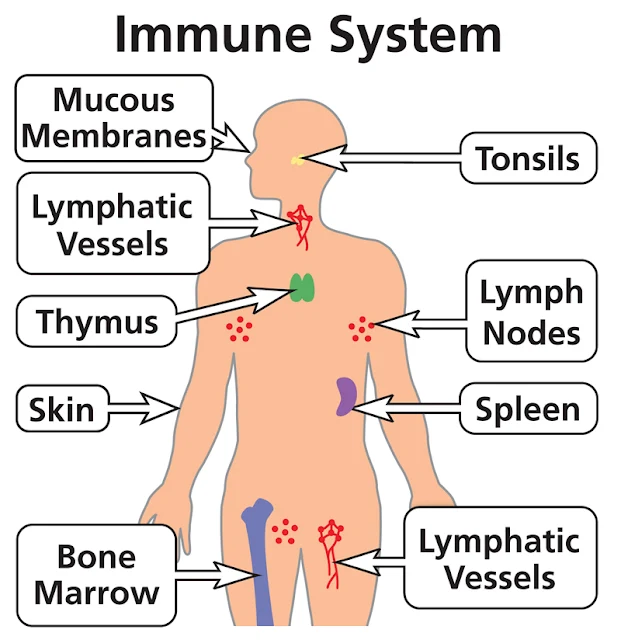INTRODUCTION: Several tissues and organs play roles in host defenses and are functionally classified as the immune system. In the human body, the primary immune parts are the lymphoid organs; the thymus and the bone marrow. All cells of the immune system are originally derived from bone marrow and that cellular lineage is known as the Pluripotent stem cells.
IMMUNE CELLS FROM THE BONE MALLOW: Pluripotent stem cells differentiate into lymphocyte, granulocyte, monocyte, erythrocyte, and megakaryocyte populations. Deficiency or dysfunction of the pluripotent stem cell or the various cell lines developing from it can result in immune deficiency disorders of varying expression and severity.
THYMUS GLAND AND IT’S ROLE IN IMMUNITY: The thymus, derived from the third and fourth embryonic pharyngeal pouches, functions to produce T lymphocytes and is the site of initial T lymphocyte differentiation. Developing T cells in the thymic cortex are first positively selected for their ability to recognize self-peptides which are, major histocompatibility complex (MHC). In subsequent negative selection, T cells that avidly recognize self-peptides are destroyed, thus removing deleterious self-reactive clones. The thymus also regulates immune function by secreting multiple bioactive substances that promote T-lymphocyte differentiation and are essential for T-lymphocyte–mediated immunity.
OTHER LYMPHOID ORGANS IN THE HUMAN BODY: In mammals, the lymph nodes, spleen, and gut-associated lymphoid tissue are secondary lymphoid organs connected by blood and lymphatic vessels. Lymph nodes are strategically dispersed throughout the vasculature and are the principal organs of the immune system that deliver and localize antigen, promoting adaptive immunity through cell–cell interaction and lymphocyte activation.
LYMPH NODE AND THEIR ROLE IN IMMUNITY: Lymph nodes have a framework of reticular cells and fibers that are arranged into a cortex and medulla. B lymphocytes, the precursors of antibody-producing cells, or plasma cells, are found in the cortex, as well as in the medulla. T lymphocytes are found chiefly in the medullary and paracortical areas of the lymph node.
THE SPLEEN AND IT’S ROLE IN IMMUNITY: The spleen filters and processes antigens from the blood and is functionally and structurally divided into B-lymphocyte and T-lymphocyte areas, similar to those of the lymph nodes. The spleen also removes damaged blood cells and immune complexes, including antibody-coated microbes. Loss of the spleen, through traumatic causes or therapeutic splenectomy, increases host susceptibility to encapsulated bacteria, which are normally cleared through opsonization and phagocytosis in splenic tissue.
THE GASTROINTESTINAL TRACT AND IT’S ROLE IN IMMUNITY: Gut-associated lymphoid tissue, adjacent to the mucosal epithelium, includes the tonsils, the Peyer patches of the small intestine, and the appendix, all of which facilitate immune responses to the multitude of ingested antigens and commensal microbes. Like the lymph nodes and spleen, these tissues exhibit separation into B-lymphocyte–dependent and T-lymphocyte–dependent areas. Mucosal immune responses tend to generate antigen-specific IgA, and, with some orally administered antigens, T-cell anergy or tolerance may occur rather than immune stimulation. Increasingly, the commensal microbiome of the gastrointestinal tract has been recognized to shape both local and systemic innate and adaptive immune responses, influencing both health and disease for example the case of allergy or autoimmunity.
RELATED;
1. LINEAGES OF STEM CELLS FROM THE BORN MARROW
2. THE MAJOR HISTOCOMPATIBILITY COMPLEX
5. ALLERGY
6. AUTOIMMUNITY











No comments:
Post a Comment